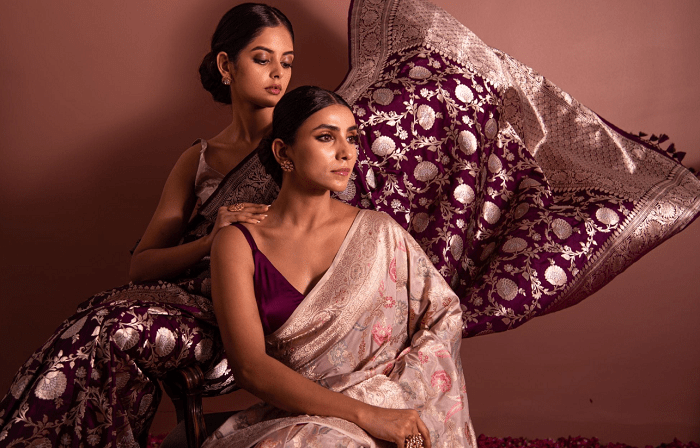Some fashion trends fade away with time, but a few stay eternal — like the banarasi saree and sharara dress. Both are iconic in their own right: one rooted in royal heritage, the other born from the nawabi elegance of North India. Together, they tell a story of how Indian women embrace culture while keeping style refreshingly modern.
The Banarasi Saree: Woven Poetry from Varanasi
A banarasi saree isn’t just fabric; it’s a masterpiece. Every thread holds centuries of artistry, reflecting the craftsmanship of Varanasi’s skilled weavers. Traditionally woven with fine silk and real gold or silver zari, these sarees were once considered royal treasures. Today, they continue to grace bridal trousseaus and festive wardrobes with the same unmatched allure.
What makes the Banarasi so special is its versatility. You can spot one at a grand wedding, a Diwali celebration, or even an elegant office event. The fabric has evolved — from heavy brocades to lightweight silk blends — without losing its luxurious touch.
Popular styles in Banarasi sarees include:
- Katan Banarasi Sarees:Known for their rich silk and zari motifs. Perfect for weddings.
- Organza Banarasi Sarees:Lightweight with intricate patterns — ideal for festive brunches.
- Georgette Banarasi Sarees:A modern take for younger women who prefer flowy drapes.
Pro tip: Pair your banarasi saree with temple jewellery or kundan chokers for that regal finish. If you want a contemporary twist, style it with a statement belt or a sleeveless blouse — fusion done right!
The Sharara Dress: Old-World Charm with a New-Age Twist
If sarees speak of grace, the sharara dress is all about flair. Originating in the Mughal era, this outfit was the go-to for royal women. Today, it’s making a massive comeback in Indian wedding and festive fashion.
The beauty of the sharara lies in its structure — wide-legged flared pants paired with a short kurti and a dupatta. It’s flowy, flattering, and perfect for twirling your way through any function.
Modern designers have reimagined the sharara dress in dreamy pastels, velvet finishes, sequins, and chikankari embroidery. Whether you’re attending a sangeet, engagement, or Eid celebration, it’s the outfit that makes you look elegant without effort.
Trending styles in shararas include:
- Peplum shararas:Fun and youthful, with a cinched waist that adds shape.
- Anarkali shararas:A long kurta paired with a subtle flare — great for traditional events.
- Cape shararas:The fusion favorite, giving off Indo-western vibes with sheer or embroidered capes.
Style hack: Pair your sharara dress with jhumkas, a sleek ponytail, and nude heels. You’ll look modern yet totally desi-chic.
When Heritage Meets High Fashion
What’s truly beautiful about today’s Indian fashion is how it celebrates diversity. You can wear a handwoven banarasi saree one day and a designer sharara dress the next — and both will feel equally you. It’s no longer about choosing between tradition and trend; it’s about merging them seamlessly.
Celebrities, influencers, and brides alike are embracing this shift — pairing Banarasi sarees with contemporary blouses or styling shararas for destination weddings. And honestly, that’s the essence of Indian fashion today: rooted, radiant, and refreshingly reinvented.
Final Threads
If you’re building a festive or wedding wardrobe, these two are must-haves. The banarasi saree will always lend you a royal aura, while the sharara dress lets you move, groove, and shine in style.
Because whether it’s a silken drape or a twirling silhouette, Indian fashion isn’t just about what you wear — it’s about how beautifully you carry your story.


